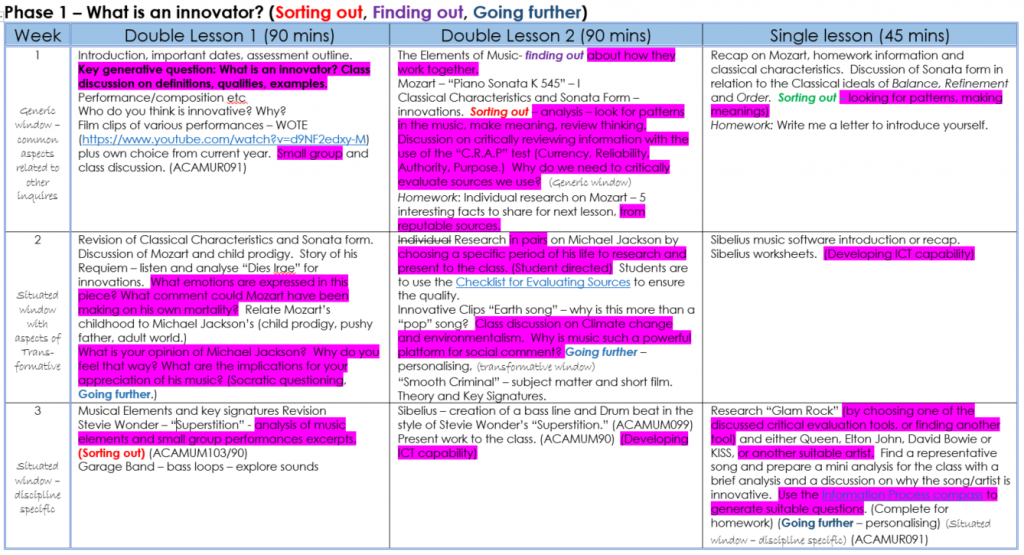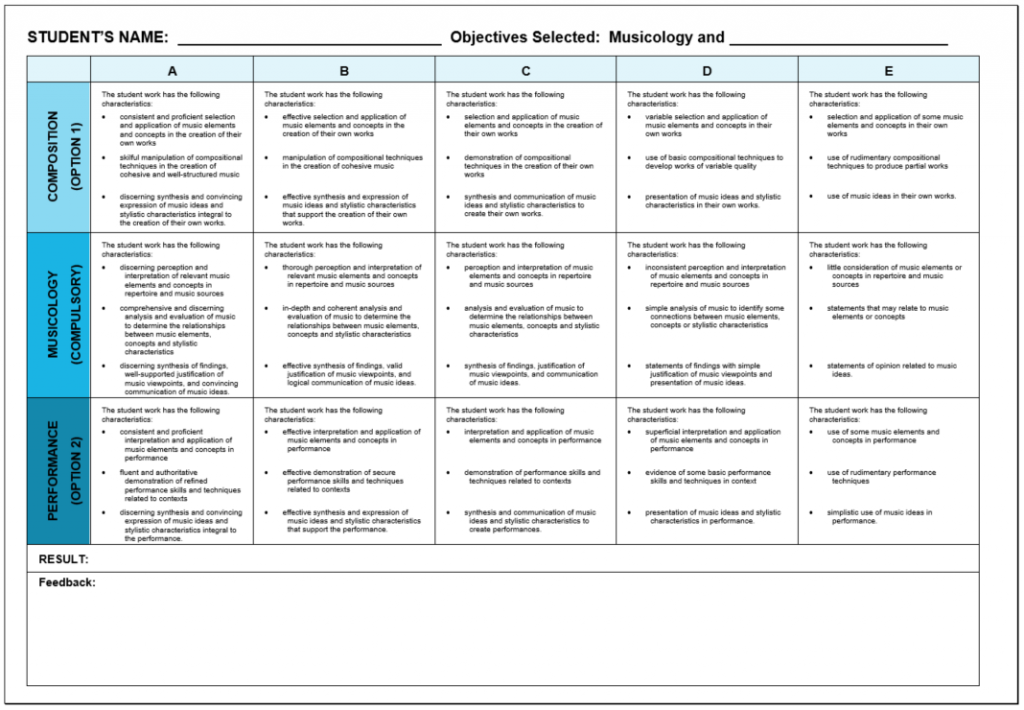After carefully analysing the existing unit of work, (found here), and applying the suggested recommendations, I went through the week-by-week teaching outline to modify the delivery of the unit. Before starting, I consolidated the learning objectives for the unit, based on the Australian Curriculum content descriptors for Years 9-10 “The Arts.” The revised learning objectives are shown below.

Based on Kath Murdoch’s Phases of Inquiry, I decided to split the unit into three over-arching phases as follows: (bubbl.us diagram created by the author.)
Below are screen shots of the Week-by week teaching outline, presented in the three separate phases. Below each screen shot is a justification and rationale explaining my redesign choices. The additions or changes in the unit from the original version are highlighted in pink.
The revised three page unit outline can be downloaded as a word document here.

Justification and Rationale for Phase 1:
Weeks 1-3 of the revised “Innovators” unit are designed to provide the students with the tools they will need to successfully complete the term’s work. As an educator, my goal is always to engage and excite the students in the work ahead from the first lesson, so I haven’t changed too much in Week 1, except to include some small group discussion and introduce the idea of critical literacy and reliability of sources – something that was clearly identified as lacking in the original unit. I really enjoy teaching the first lesson in this particular unit as the challenge is always to make sure that the various performances that I show as examples of innovation are relevant, interesting and thought-provoking for the students. In recent years, Walk Off The Earth’s innovative performance of Goyte’s hit, “Somebody That I Used To Know” has always generated animated discussion on what it means to be innovative. It’s surprising how many excellent suggestions come from the students as well. The first week of learning is situated mostly in the Generic Window as students learn aspects of inquiry that are common and relate to other subject areas.
Week 2 of the redesigned unit has a similar structure to the original, but I have tried to incorporate more Generative questioning frameworks by utilising those strategies suggested by Alex Quigley in his blog. Rather than asking students to do a straight analysis of Mozart’s “Dies Irae,” they are now asked to comment on the emotions expressed in the piece and to discuss how they believed Mozart would have been feeling about his own mortality. Students are also now asked to give their pre-conceived idea of Michael Jackson and how this may or may not affect how they feel about his musical output. Also incorporated into the analysis and evaluation of Jackson’s “Earth Song” is a discussion on climate change and the reasons why music is such a powerful platform for social comment. “Going further” in this phase, students could also find other songs or artists known for their social commentary. Week 2 involves more of the Situated window as questions are more discipline specific, along with some aspects of the Transformative window, as students are asked to search their own conscience, critique society and give opinions important issues. (Please refer to the Analysis and Recommendations page for information on Mandy Lupton’s GeSTE windows.) Week 3 sees a continued focus on critical literacy and also incorporation of informal performance. Again, the original analysis showed that some more performance opportunities could have been incorporated to satisfy the content descriptors. The mini-project on “Glam Rock” is broadened slightly to allow for student choice, and the Information Process Compass is used to help students generate effective questions.

Justification and Rationale for Phase 2:
Weeks 4-6 of the revised “Innovators” unit are designed to allow students to apply what they have learned so far to their own development as musicians, performers and composers, with the eventual long-term aim of developing their own unique style. In the analysis, it became apparent that many of the content descriptors of the F-10 Arts syllabus referred to the development of individual style in performing and composing. This was an area that was lacking in the original unit. The central question of Phase 2 of the unit is now, “How can I be innovative” which will hopefully shift the focus more towards applying learning to the development of individual innovation. Phase 2 is based on the “Tuning in to students’ thinking” and “Synthesising and Reflecting” areas of Kath Murdoch’s phases of Inquiry, and ideally, by the end of week 6, students will be well prepared to move to the final phase, “Acting and Applying.” As so much of Phase 2 of “Innovators” now focuses on personal connection and expression, the “Expressive” GeSTE window is most fitting. Again, questioning has been refined to focus more on emotional connections. Another important inclusion is the opportunity for students to start to think about how they could apply their learning so far to the creation of an original composition in any style.

Justification and Rationale for Phase 3:
Weeks 7-9 of the revised “Innovators” unit are designed to allow students to demonstrate their understanding of the topic and apply this to their own choice of artist/s. I’ve changed the delivery of the unit so that the final 3 weeks provide an intensive opportunity to engage in the subject matter and complete the major assessment task. The assessment task has been expanded to include the student’s choice of either a short composition or performance that relates to their analysis and research on their chosen artist and associated repertoire. As the Year 10 Music unit is also intended to prepare students for the year 11 and 12 course, I have decided to keep using the senior level criteria in the awarding of standards. The Draft 2 of the new QCAA Music curriculum redevelopment that was released this year moved away from assessing one objective (i.e., Musicology, Composition or Performance) per task. Instead, they are proposing some assessment tasks that involve 2 or 3 objectives as a richer learning experience. I have used this concept in the redevelopment of the major assessment task for the “Innovators” unit in the hope that it will prepare students for the same structure in Years 11 & 12. A downloadable copy of the assessment task as a word document can be found here. Screen shots below also show the new assessment task with the expanded requirements.


Fostering student engagement in the curriculum and learning experiences is crucial to the academic success of students. This importance is discussed by Joyce Hurt in her article “Utilizing Students’ Passions and Interests to Create a More Meaningful Research Experience” (2015). This article speaks of Hurt’s own memories as a student and how she was so happy to be given the opportunity by her Music professor to share her passion for Stevie Nicks with her classmates. This memory stayed with her as she created opportunities for her students to shine by celebrating their uniqueness and allowing them to undertake research projects on their own specific interests. She uses these “passion projects” as an opportunity for those students with varied interests who may not generally be comfortable with presenting projects to the class, to demonstrate their expertise in their chosen area. (Hurt, 2015. p. 37) The projects are appropriately scaffolded with careful planning and negotiation of the conditions between student and teacher, but the students are given the freedom to negotiate the content and decide the most effective way to present their project. In this same way, the new assessment task I have designed allows for this freedom. Hurt makes very valid points in her discussion of the inquiry-based nature of the projects, and states that the students remained engaged throughout, in turn learning more about themselves and each other. To also facilitate this, I have added a formalised peer review aspect to the assignment, in part based on how much I have appreciated that aspect of this current assignment I am working on now. In my own practice, I strongly believe that if a student is engaged, they are more likely to remain motivated and learn the necessary skills, and I hope that the re-design of the “Innovators” unit will provide even more opportunity and scope for student development, engagement and enjoyment. I am looking forward to the opportunity to teach the redesigned unit in the near future.
References:
A.C.A.R.A. (2016) The Arts: Introduction – The Australian Curriculum v8.2. Retrieved from Australian Curriculum http://www.australiancurriculum.edu.au/the-arts/introduction
Bell, R. L., Smetana, L., & Binns, I. (2005). Simplifying inquiry Instruction. The Science Teacher, 72(7), 30-33. Retrieved from http://gateway.library.qut.edu.au/login?url=http://search.proquest.com.ezp01.library.qut.edu.au/docview/214615319?accountid=13380
Hurt, J. (2015). Utilizing students’ passions and interests to create a more meaningful research experience. Delta Kappa Gamma Bulletin, 81(2), 37-40. Retrieved from http://gateway.library.qut.edu.au/login?url=http://search.proquest.com/docview/1647369514?accountid=13380
Lupton, Mandy (2016). Inquiry learning. A pedagogical and curriculum framework for information literacy. (preprint) in Sales, Dora & Pinto, Maria (Eds.) Pathways into InformationLiteracy and Communities of Practice: Teaching Approaches and Case Studies. Chandos Publishing. (In Press)
Lupton, Mandy and Bruce, Christine. (2010). Chapter 1 : Windows on Information Literacy Worlds : Generic, Situated and Transformative Perspectives in Lloyd, Annemaree and Talja, Sanna, Practising information literacy : bringing theories of learning, practice and information literacy together, Wagga Wagga: Centre for Information Studies, pp.3-27. Retrieved from https://qut.rl.talis.com/items/61F3BA08-8F5F-5301-04AE-ADDA69D4806E.html
Martin-Hansen, L. (2002). Defining inquiry. The Science Teacher, 69(2), 34-37. Retrieved from http://gateway.library.qut.edu.au/login?url=http://search.proquest.com.ezp01.library.qut.edu.au/docview/214619720?accountid=13380
National Research Council. (2000). Inquiry and the National Science Education Standards. A Guide for Teaching and Learning. Washington: Centre for Science, Mathematics, and Engineering Education. Retrieved from https://www.nap.edu/read/9596/chapter/1
QCAA. (2016). Draft 2 consultation – Arts. Retrieved from Queensland Curriculum and Assessment Authority: https://www.qcaa.qld.edu.au/senior/new-snr-assessment-te/redev-snr-syll/draft-2-consultation/arts
All other references are provided as links throughout the post.